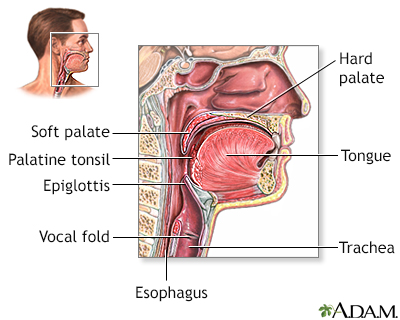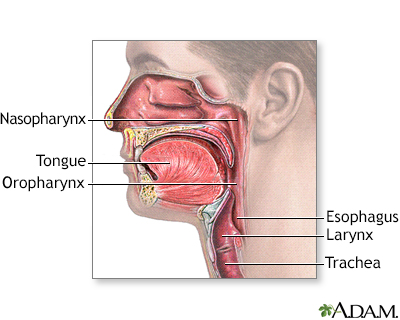Retropharyngeal abscess
Retropharyngeal abscess is a collection of pus in the tissues in the back of the throat. It can be a life-threatening medical condition.
Images


I Would Like to Learn About:
Causes
Retropharyngeal abscess most often affects children under age 5, but it can occur at any age.
Infected material (pus) builds up in the space around the tissues at the back of the throat. This can occur during or very soon after a throat infection.
Symptoms
Symptoms include:
- Breathing difficulty
- Difficulty swallowing
- Drooling
- High fever
- High-pitched sound when inhaling (stridor)
- Muscles between the ribs pull in when breathing (intercostal retractions)
- Severe throat pain
- Difficulty turning the head
Exams and Tests
The health care provider will perform a physical exam and look inside the throat. The provider may gently rub the back of the throat with a cotton swab. This is to take a sample of tissue to check it more closely. It is called a throat culture.
Other tests may include:
- Complete blood count (CBC)
- CT scan of the neck
- X-ray of the neck
- Fiber optic endoscopy
Treatment
Surgery is needed to drain the infected area. Corticosteroids are sometimes given to reduce airway swelling. High-dose antibiotics are given through a vein (intravenous) to treat the infection.
The airway will be protected so that it does not become completely blocked by the swelling.
Outlook (Prognosis)
It is important to get medical help right away. This condition can lead to blockage of the airway. This is a life-threatening medical emergency. With prompt treatment, a full recovery is expected.
Possible Complications
Complications may include:
When to Contact a Medical Professional
Contact your provider if you or your child develops a high fever with severe throat pain.
Get medical help right away if you have:
- Breathing trouble
- High-pitched breathing sounds (stridor)
- Retraction of the muscles between the ribs when breathing
- Difficulty turning the head
- Difficulty swallowing
Prevention
Prompt diagnosis and treatment of a sore throat or upper respiratory infection can prevent this problem.
Related Information
Peritonsillar abscessFever
Abscess
Aspiration
Breathing difficulty
Osteomyelitis
Mediastinitis
References
James P, Hanna S. Upper airway obstruction in children. In: Bersten AD, Handy JM, eds. Oh's Intensive Care Manual. 8th ed. Philadelphia, PA: Elsevier; 2019:chap 106.
Pappas DE, Boggs SR. Retropharyngeal abscess, lateral pharyngeal (parapharyngeal) abscess, and peritonsillar cellulitis/abscess. In: Kliegman RM, St. Geme JW, Blum NJ, et al, eds. Nelson Textbook of Pediatrics. 22nd ed. Philadelphia, PA: Elsevier; 2025:chap 432.
Roginski MA, Atchinson PR. Upper respiratory tract infections. In: Walls RM, ed. Rosen's Emergency Medicine: Concepts and Clinical Practice. 10th ed. Philadelphia, PA: Elsevier; 2023:chap 61.
BACK TO TOPReview Date: 10/28/2024
Reviewed By: Ashutosh Kacker, MD, FACS, Professor of Clinical Otolaryngology, Weill Cornell Medical College, and Attending Otolaryngologist, New York-Presbyterian Hospital, New York, NY. Review provided by VeriMed Healthcare Network. Also reviewed by David C. Dugdale, MD, Medical Director, Brenda Conaway, Editorial Director, and the A.D.A.M. Editorial team.

Health Content Provider
06/01/2025
|
A.D.A.M., Inc. is accredited by URAC, for Health Content Provider (www.urac.org). URAC's accreditation program is an independent audit to verify that A.D.A.M. follows rigorous standards of quality and accountability. A.D.A.M. is among the first to achieve this important distinction for online health information and services. Learn more about A.D.A.M.'s editorial policy, editorial process and privacy policy. A.D.A.M. is also a founding member of Hi-Ethics. This site complied with the HONcode standard for trustworthy health information from 1995 to 2022, after which HON (Health On the Net, a not-for-profit organization that promoted transparent and reliable health information online) was discontinued. |
The information provided herein should not be used during any medical emergency or for the diagnosis or treatment of any medical condition. A licensed medical professional should be consulted for diagnosis and treatment of any and all medical conditions. Links to other sites are provided for information only -- they do not constitute endorsements of those other sites. © 1997- 2025 A.D.A.M., a business unit of Ebix, Inc. Any duplication or distribution of the information contained herein is strictly prohibited.
